February 15, 2015
A stolid Russian publication "The Military-Industrial Courier" published an article by Alexey Ramm (in two parts) that parsed actions of Ukrainian military. It became widely cited in narrow circles, at places like Topwar and Leshiy. As usual, commenters seem to prefer to bend it to their agenda. Leshiy, in particular, pointed out how Ramm "conclusively debunked" the "delusions" about the participation of Russian armed forces. Having actually read the source, I say that Ramm does no such thing. He makes no claims about the composition of the Novorossian militias, only lays down the facts about their relatively low numbers, initially poor armaments, which were gradually, but constantly bolstered by trophies, and what their combat actions were from the point of view of Ukrainian staff.
Due to the place of publication, and targeting the print format, the article is quite long. I invite those interested to Google-translate it themselves. What I found interesting is Ramm's original focus on the way Ukrainians adopted our lessons and how that brought them to ruin in the 1st massive defeat during the summer 2014. Here, I refer to the Illovaisk defeat as the 2nd one, while Ramm only describes the ill-fated "march along the border" in his article.
Leaving all the boring facts, Ramm's executive summary follows in my translation. Observe in particular how he summarizes our actions before and during "The Surge". "ATO" is the Ukrainian newspeak for the war in Novorossia (it translates literally as "Anti-Terrorist Operation"). Emphasis mine throughout.
In the first clashes of May - June, Ukrainian command largely acted upon the American experience of anti-guerilla operations in Afghanistan and Iraq. Not only in the ATO Command, but in Sector commands, there was a number of officers who educated in [military] colleges of NATO countries. According to the experience of Ukrainian detachment in Iraq, manuals were printed and distributed on the topics of making marches, blocking/checking towns, controlling roads, and carrying out the functions of checkpoints. Actual American [Army] field manuals were translated and distributed as well on [additional] topics of storming [towns], providing intelligence support, and CQB.
[...]
Initially, the core [of the plan] was composed upon the American experience of 2004-2005. Back then, the mechanized/mobile groups, by performing a decisive march upon roads, occupied the assigned sites, placing checkpoints along the way. Attacks of the enemy were repulsed by fire of APCs and tanks on the move, with attached mortar support involved as required. Such actions permitted not only take control of roads, towns, bridges, and intersections, but largely immobilize the enemy, limiting his movements to desired regions. [Thus,] in 2004-2005, U.S. military, although with difficulty, achieved all assigned objectives.
The ATO Command planned to use Batallion (BTG) and Company (RTG) tactical groups analogously to American mobile groups. Similarly, the routes of marches for the groups were planned along roads. At the march, mostly single, greater capacity road [or highway] was used, and at intersections with secondary, unpaved roads checkpoints were installed [manned by secondary units].
Towns were supposed to be blocked by checkpoints at all roads. While executing the march, BTG and RTG assigned only avant-guard and arrier-guard. Because the Command did not expect active resistance with modern and heavy weapons, flank guards were not assigned, and their functions were assigned to checkpoints. [On reflection it seems that] the plan expected resistance by guerilla armed with light arms and rocket-propelled grenades.
The Command missed that in Iraq, American mobile groups consisted of 2..3 re-enforced infantry squads with 1..2 squads for checkpoints. They acted in a desert landscape with good visibility, and performed marches at night, making a good use of superior night vision equipment. The supply of mobile groups was done by helicopter. Only after blocking of towns, the supply by truck was established.
The Command assigned cumbersome BTG and RTG as mobile groups, having dozens, at times hundreds, of vehicles, which required a constant supply by all kinds of materiel.
One of the recurrent motifs of Putin's propaganda lapdogs recently was that the supply of modern arms to Ukrainians will do no good, not only because it will be stolen, but because Ukrainians are not capable of deploying those arms. I have to admit that there's some truth to that, and that's despite of Ukraine having the actual experience fighting as part of multi-national coalition. The debacle that ensued when they tried to ape us in combat should underscore just how valuable West Point really is.
For the record, my reservations against arming Ukraine are generally financial. They aren't fighting an important or good fight, despite the duplicitous propaganda about the horrors of Putin's aggression. All Ukrainians are trying to do is to genocide ethnic Russians. What do we care? So, if they want to buy good armaments from us, then sure, why not. But giving them arms for free should take a backseat to giving arms to Kurds. IMHO, of course. And this should not be mixed up with the topic of such arms supply being wasted upon Ukrainians. We already give M1 tanks to Iraq government, which promptly loses them to ISIL, so what difference does it make? In fact, it's probably better to gift them to Putin via Ukrainians, than to ISIL.
But anyway, reading Ramm demonstrated to me once again just how much the American military might turns upon the smarts nowadays. Now I expect liberals do their utmost to infiltrate and destroy military academies first. And we'll never know about it, because MSM will cover it for them.
P.S. Cannot resist a bit more, for the taste:
[By the July 12,] the Height 27, or what later became famous as the Saur-Mogila hill, was occupied by militia. Notably, according to the initial plan, the height was supposed to be taken even before the general advance, by Spetsnaz battalion "Azov" of MVD. But on July 4, the volunteers of "Azov" unexpectedly collided with minutemen, who already took defence on the hill. The personnel of "Azov" advanced upon the hill in civilian vans, which were destroyed in the first minutes of the fight among and near the service buildings of the memorial.
Ukrainian army then tried to take Saur-Mogila with the strength of an RTG of the 79th Brigade on July 12, but that storm was repulsed. They tried again with 1 BTG and 1 RTG of the 25th Airborne, 1 BTG of 51st, and 1 BTG of 95th on July 25. The Airborne managed to occupy the hilltop for a short time, but were unable to maintain control. Another storm was carried out on August 6. For that failure, the CO of the 51st Pavel Protsuk was dismissed. Finally, the 25th Airborne took the Saur-Mogila on August 9. However, by that time, the whole operation collapsed all around them and this Pyrrific success did Ukrainian side no good.
P.P.S. As you can imagine, certain people derived poorly founded historic parallels and tried to score propaganda points.

The general view of the memorial before the war (2010).
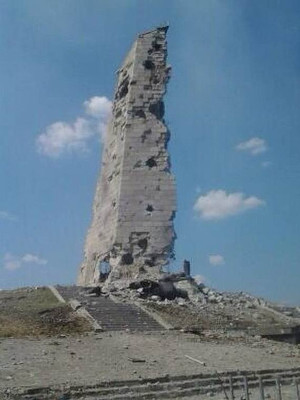
The main pillar was still standing on August 8.
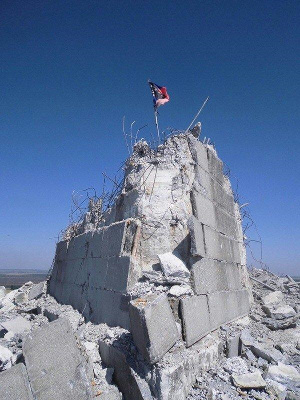
The remains of the monument were finally taken by DNR's army units and militias at the end of August.
Posted by: Pete Zaitcev at
10:40 AM
| Comments (4)
| Add Comment
Post contains 1178 words, total size 8 kb.
February 03, 2015
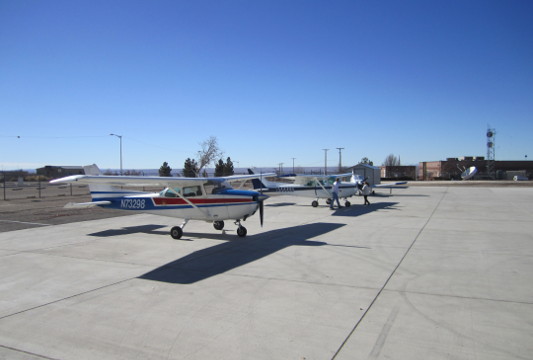
I passed so-called Flight Review recently. It basically is a re-examination, although administered by a CFI, not DPE or FAA inspector, and one practically cannot fail it (because attempts are not limited). The governing regulation is 14 CFR 61.56, that says:
(c) Except as provided by paragraphs (d), (e), and (g) of this section, no person may act as pilot in command of an aircraft unless, since the beginning of the 24th calendar month before the month in which that pilot acts as pilot in command, that person has —
(1) Accomplished a flight review given in an aircraft for which that pilot is rated by an authorized instructor; and
(2) A logbook endorsed from an authorized instructor who gave the review certifying that the person has satisfactory completed the review.
If your eyes glaze over from reading the above, imagine a world where every driver has to go to DMV and take a biennial re-examination, just to make sure they still remember how to drive.
IMHO, as far as the red tape goes, Flight Review is rather innocuous. As I mentioned, it cannot be failed, realistically speaking. Sport Pilots are subject to Flight Review, but really, there's no comparison with the strictures of medical certification, so it's no big deal and may even be a positive influence. Not that I would ever support Drive Review. Leave that to truly fascist countries.
Posted by: Pete Zaitcev at
11:54 AM
| Comments (3)
| Add Comment
Post contains 235 words, total size 2 kb.
No, I'm not buying a motorcycle, it's a quote from an informative post at PoA that demistifyes how the red tape kills flying (written by a flight instructor struggling to find students):
Money is likely the biggest problem why someone chooses NOT to learn to fly once I talk with them. After we take the discovery flight the next obstacle that's absolutely devastating is the medical.
In the last month I've generated maybe 10 good leads. Converted 4 of them into discovery flights (these are the people of the 10 that could afford it) and of those 4 none of them could get issued a medical on the spot by an AME. I suspect maybe 1 of them will follow through on my advice to work through their issue with Dr Bruce.
The medical problems of the four:
1.) Young and received a minor in possession of alcohol standing outside of his apartment. About six months before he turned 21. We'll likely work past this.
2.) Young and sees a shrink regularly and is on an anti-depressant. Not interested in jumping through any hoops and just decided they didn't want to fly when they learned there would be significant challenges getting issued a medical.
3.) Young and was "diagnosed" with ADHD at a young age and was given prescription pills that he took for quite a long time but no longer does. He threw in the towel when he found out there would be significant hoops to jump through.
4.) In his 50s, a few DUIs years back but none for many years. When he found out that he may have to get some paperwork together for the Feds he was basically like F the Feds I'll just buy a new motorcycle instead.
I can sympathise. In fact, although I hold a current 3rd Class, I'm very nearly thinking the same. That's why I'm interested in things like Affordaplane, which are not regulated under the same rules. Note, however, that the modern red tape comes in many forms. For example, you cannot fly one of these contraptions if you live near a Class Bravo airport. The post-9/11 TFRs apply to ultralight pilots fully, and you bust one, you get your kidneys kicked in by Secret Service goons only because Uncle Biden was fundrising nearby.
Another thing about the missive above is that it makes no mention of the Sport Pilot, which does not require medical certification [1]. Of course, it's heavily hamstrung: only 1 passenger (so no family vacations), no flying at night, no flying on instruments, no flying above 10,000 ft except below 2,000 ft AGL. Still, it's not a bad deal. The equipment is pretty decent and will get your places.
[1] As long as you did not foolishly seek such certification in the past and failed it. At which point, it's glider time.
Posted by: Pete Zaitcev at
10:58 AM
| Comments (3)
| Add Comment
Post contains 484 words, total size 3 kb.
January 24, 2015
In an article in Washington Times a few days ago, someone called Maggie Ybarra makes the following absurd claim:
The Federal Communications Commission is considering a plan to route U.S. emergency 911 location calls through a Russian satellite system, raising national security alarms inside a Congress dubious of Moscow’s intentions.
I don't think that Maggie Ybarra is a bald-faced liar or a Republican propagandist. Instead, the phrasing seems to indicate that Maggie Ybarra lacks basic understanding of how everyday technology works. The very next paragraph in her opus is factually correct, although incomplete and misleading:
In a proposal before the FCC, the 911 emergency system would rely on the Russian Federation’s GLONASS precision navigation and timing satellite system to locate people calling 911 from their mobile phones.
Least you think Maggie Ybarra is the only journalist in America who is just that ignorant, Andrew Malcolm of IBT reblogged the story thus:
In an alarming story, the Washington Times reports the communications companies believe having the calls routed through Russian satellites would enhance the accuracy of their call locators [...]
The imaginary "911 location calls" of Marie Ybarra have turned into plain old calls of Andrew Malcolm. Naturally, the result is:
Of course, such a system would also give Russians access to the American emergency response network, including the precise locations of every U.S. first responder.
No, it will not, you lying sack of shit.
GLONASS is a Russan clone of GPS, and its receivers do not transmit anything back to its satellites.
P.S. Instapundit (on this blog's blogroll!) runs the story under the headline "WHAT COULD GO WRONG? Wait! What? FCC ponders plan to route U.S. 911 calls through Russian satellites." I cannot imagine the good Professor being that ignorant, even though he's a professor of law. Most likely he didn't read the story he linked.
P.P.S. I suspect I'll be sorry to bring facts into this massive pile of lies and delusion, but actually, a system already exists that already transmits American distress calls through Russian satellites (among other things: it also transmits calls from Russian distress locations through U.S. satellites). It is called COSPAS-SARSAT and its U.S. component is maintained by NOAA. You can buy a terminal at Amazon. The workings of SARSAT are entirely different from what the sad excuse for journalism above rails about. Since, unlike a E911 cellphone, a PLB does not have a data or voice connection with ground infrastructure, it has to tell the rescuers your location somehow. In this case, by seding the signal to (possibly Russian) satellites, which then re-transmit it to relevant agencies of the member countries. I was actually thinking about getting one of those before my big coast-to-coast adventure that I'm plotting here. The privilege of telling Russians where you are is pretty costly though!
Posted by: Pete Zaitcev at
02:24 PM
| Comments (2)
| Add Comment
Post contains 477 words, total size 4 kb.
January 19, 2015
A senseless fatal crash happened in Florida on January 13. A visiting time-builder from Japan was killed: Mihoko Tabata, 38. The scenario was not that unusual: weather reported at departure overcast 600 feet, but the fog was moving in and the observation changed to overcast 200 soon thereafter. A poster at PoA, based at the same airport, was driving that night and reported dense fog. Tabata took off well after sunset, at 9 p.m..
The discussion, as often, took a few nasty turns. Tabata's qualifications were called into question, as well as qualifications and integrity of her instructors and examiners. The most striking thing is, she was well qualified for the task at hand: a 400 hour Commercial Pilot, AMEL, IR. Once she gone blind, she could have easily filed a pop-up IFR plan. Or simply declared an emergency. But instead, she descended over ocean and impacted on a beach. Police fished her body out of the surf. Why?
Personally, I don't expect that she pencil-whipped her hours or bribed her DPEs. She simply lost her head, I think. The evidence of that is, Tabata was in contact Daytona Approach and her English speech became incomprehensible as she fought to keep the airplane under control. There was no icing and no storm that night. Fear did her in, nothing else.
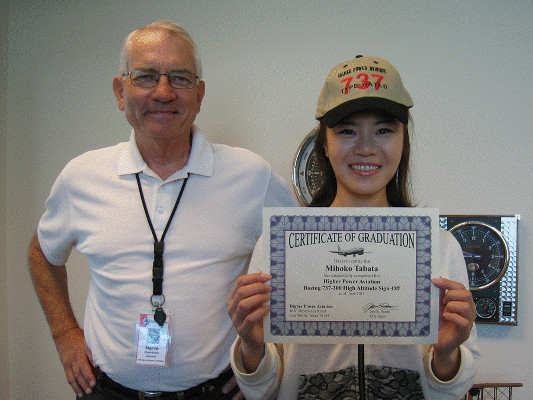
Posted by: Pete Zaitcev at
04:04 PM
| No Comments
| Add Comment
Post contains 224 words, total size 2 kb.
December 25, 2014
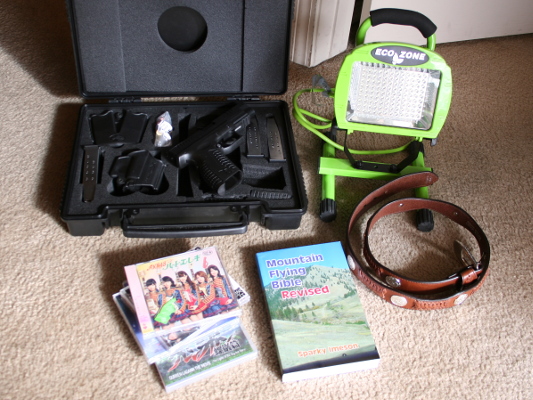
The 2014 was a fat year. I got a New Mexican belt, a work light, Sparky Emerson's mountain flying bible, a pack of weaboo media, and a new gun. The belt should go well with my bolo. It was my daughter's idea, very nice.
The worklight is basically a necessity for any jeeper, but I'm way stingy, and managed for years with a headlight and sometimes grabbing a flashlight with my teeth. It was ridiculous enough that my family noticed.
Sparky's book was on my list since before the Carlson. Unfortunately, flying Carlson around here turns every flight into a dangerous mountain trip. For example, at one point I had to ride ridges just to get from Carrizozo (F37) to Sierra Blanka (SRR) and almost killed myself by missing a power line. So, strangely enough, I pretty much taught myself the basics by trial and error. Still, it's a good book. And I read Stick and Rudder way late as well. (Do keep in mind that all mountains are different and I'm going to read twice what Sparky says about Utah.)
The gun is an XD(m) in .45 ACP and is actually my first gun of the kind. Very nice, and an expensive present at that. I was waffling a lot if I wanted a 9mm or .45, but this clinches it. Come to think of it, my wife made me buy the BLR and the Nova, too. So, I let her decide my guns an awful lot, but she seems to know what gun I want better than I do, and so far it worked very well. Next, going to go out on a date to Caliber, and maybe a dinner.
Posted by: Pete Zaitcev at
11:52 AM
| Comments (1)
| Add Comment
Post contains 284 words, total size 2 kb.
December 02, 2014
Quoting Doug Bandow verbatim:
Terrorism remains a serious security concern, but Washington could cut that risk by ending its promiscuous intervention abroad. Constantly bombing, invading, and occupying other nations creates enemies.
It is not some kind of deluded liberal, but "a senior fellow at the Cato Institute", reproducing the cornerstone of appeasement and dhimmitude.
Posted by: Pete Zaitcev at
08:23 PM
| Comments (1)
| Add Comment
Post contains 60 words, total size 1 kb.
November 15, 2014
Make no mistake, Denki-Gai no Honya-san is a terrible anime. But...

Just a close-up.

Not giving too many spoilers, but Sensei is staying in the office overnight.

There was more to it. But, spoilers again.
Tags: anime
Posted by: Pete Zaitcev at
06:26 PM
| Comments (7)
| Add Comment
Post contains 41 words, total size 1 kb.
October 27, 2014
Back when I bought the banned cans, I knew that our masters in Washington, D.C. will find a way to top that. Bought some tires online today, and the confirmation e-mail contained the following peculiar notice:
Note: As a complimentary service to you, the Tire Identification Codes for the tires you purchased have been automatically registered with the Department of Transportation (DOT).
The only reason for this that I can imagine is if they ever find a tire in a landfill, they identify it, then send a SWAT team to apprehend you (and then they kill you by accident).
Oh and if you sell your old tires to a guy who cuts your lawn, it's a felony, probably.
Posted by: Pete Zaitcev at
04:09 PM
| Comments (1)
| Add Comment
Post contains 123 words, total size 1 kb.
October 21, 2014
As a part of long-format fly-in in Page, AZ, a circus of Flight Design CTs visited Cal Black, UT (U96) on October 18. Photographed is an assembly of 6 CTSW and 5 CTLS models, 11 total.
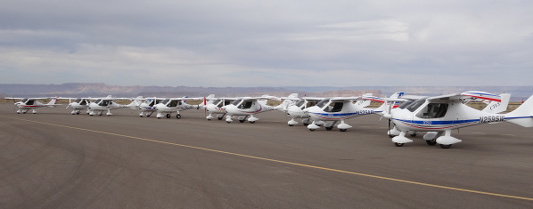
The picture is basically what the present (or future) of personal aviation could look like if the American middle class kept their money. The increased pressure from the regulation created the LSA format: a light (600 kg gross), 2-seat airplane with a maximum speed of 120 knots. More than 100 companies threw their hats into the ring of the LSA competition, and the Flight Design emerged victorious. Their iconic product, the CT, is significantly smaller than typical "Cessna" that was the face of personal aviation in the 1980s. It is, however, much faster, burns less gas, and carries more load than Cessna 150/152, the classic 2-seater. It also includes an airframe parachute as standard equipment.
However, CT's amazing performance came at a significant price, and very few could afford it. So where Cessna sold at the order of 10,000 airplanes, Flight Design sold a 100 (current fleet in the U.S. is just above 300). Note that CT is about 1/3rd price of a new Cessna 172: $150,000 versus $450,000 in 2014. Where CT is unaffordable, the aluminum classic is downright insane (as in, you have to be clinically insane to buy one).
UPDATE: There's a video at YouTube by Loop, which focuses on CTLS and includes footage from a previous fly-in in Page.
Posted by: Pete Zaitcev at
05:57 PM
| Comments (7)
| Add Comment
Post contains 253 words, total size 2 kb.
October 10, 2014
Having despaired for buying anything good for Android at all, I have given a try to a free VN game from a D-list company: Airs by ten+cross. The game is unvoiced and its main attraction is in easy reading. Pretty much the same as Kanon, then.

Obviously, the story is not likely to be a heavy hitter like Kanon. In fact, it is didactic like The Rocket Company. The core of Airs is the eponymous computer system and the characters spend quite a bit of time on exposition and explanations of the system's features. Nonetheless, it's pleasant enough so far.
Posted by: Pete Zaitcev at
09:09 PM
| No Comments
| Add Comment
Post contains 104 words, total size 1 kb.
September 27, 2014
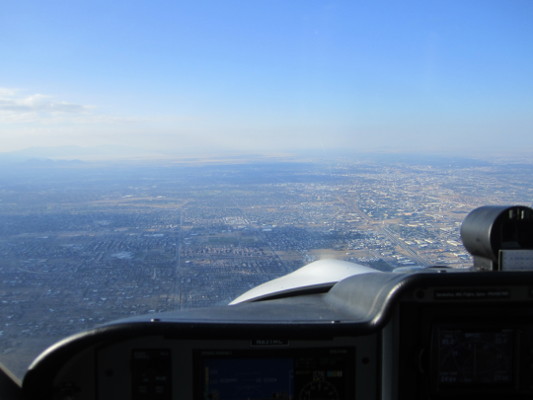
I'm back to flying Remos GX again, and there are bad news: I'm not comfortable with its ground handling anymore. For some reason, it always feels to me that airplane is about to tilt to the left, so every time I land, I dial right aileron. This causes the airplane to drift left of centerline on touchdown, because aileron deflected downwards creates drag. When I return to the center, the right turn makes me afraid even more.
Of course it's purely psychological. CTLS, for example, has an even more narrow track, and we don't see those scrapping wingtips, do we?
My reason, I think, has something to do with flying a single seater, where the pilot obviously is on the centerline.
I can make myself to do the right thing, in the same way an instrument rated pilot can overcome vertigo, but it's just not pleasant. I also have concerns as to how it's going to play out in crosswinds, where I must do the right thing without thinking about it.
Posted by: Pete Zaitcev at
08:34 PM
| Comments (4)
| Add Comment
Post contains 176 words, total size 1 kb.
September 19, 2014
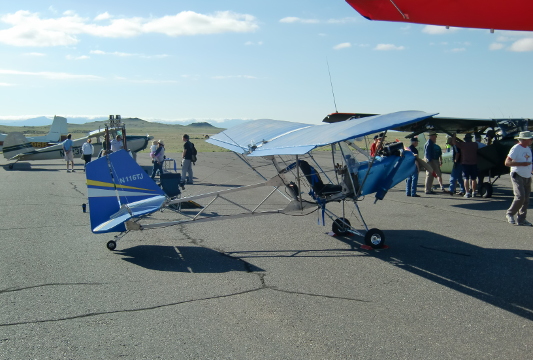
At a recent fly-in (into which I drove... oh, the indignity), I saw something special: a realy, honest, airworthy Affordaplane. For those not aware -- and who can blame you? -- the Affordaplane is an airplane for those who are even poorer than I am. You can build it for a couple of thousand dollars in materials, if you're handy enough and know your local hardware stores well. You need another two grand for an engine, but still, it's purposefuly designed to be an astonishing bargain, and extremely easy to build from scratch. By comparison, my own Carlson costs at least $9,000 to build and uses a $6,900 engine. Its core is a factory-welded space frame, that is quite challenging to make and requires special jigs. But to build Affordaplane, you only need a large workshop table, and know how to drill neat holes in aluminum. Note how its fuselage is actually a 2-dimensional frame.
It's a fantastic flying machine for those who love aviation, but cannot afford its more conventional formats. I heard it flies quite decently, too. Of course, cross-countries in Affordaplane are even more challenging than in Carlson. At my estimate, its range should be limited to 40 nautical miles. Maybe 50 with larger tanks. So it basically has limitations of a Part 103 ultralight.
Speaking of which, the cheapest factory-built ultralights come in at about $18,000..20,000 nowadays (my favourite is Aerolite 103). Building your own Affordaplane not only lets you have it cheaper, but also add larger tanks and engines. My home base is 5000 ft MSL and therefore most legal ultralights simply cannot get off the ground. The example in the photo, however, flies quite a bit.
Posted by: Pete Zaitcev at
09:22 AM
| No Comments
| Add Comment
Post contains 286 words, total size 2 kb.
September 15, 2014
In a review Joel Kotkin's book, Jay Cost summarizes the new classes thus:
Kotkin asserts that a new ruling class has emerged from the upper echelon of society, one that is starting to rival the oligarchs of the late 19th century. In the Gilded Age, it was the railroad barons, oil magnates, and sundry industrial tycoons who had in their pockets machine politicians. Today, our incipient rulers come from the technology sector, which sprung up in California and Seattle in the wake of the computer and Internet revolutions. Joining them is a new "clerisy†of elites from academia, government, think tanks, and media.
The two camps are united around the concept of so-called "gentry liberalism,†which is defined by postwar ideals such as environmentalism, consumer rights, and cultural leftism. This differentiates the new oligarchs from the old ones in important ways. The so-called Robber Barons had an interest in economic growth and, ultimately, a vibrant middle class that could afford to purchase the goods they made. Today’s would-be oligarchs lack such an incentive. As Kotkin notes, one need not be middle class to afford a smartphone. And the new oligarch’s ideological commitment to environmentalism usually means stifling development for the sake of "sustainability.â€
Arrayed against the oligarchs is a group Kotkin calls the yeoman class, a phrase that harkens back to the small, independent farmers idealized by the Jeffersonian Republicans of the early 19th century. Today’s yeomanry is not on the farm, but is composed of small businessmen and property holders. Often aligned with them are the old industries—oil, natural gas, coal, and other extracted-resource concerns—that share the yeoman’s priority for broad-based economic growth.
The observations and analysis above strike to the very heart of the issue. However, Cost finds something missing from Kotkin's work:
First, the clerisy and the tech oligarchs constitute a minority of society. For them to have a stranglehold on our democratic politics thus requires an alliance with other groups. The 19th century robber barons developed precisely such an alliance.
How does the new oligarchy possess power beyond its numbers? The answer inevitably gets back to the class that is often left out of Kotkin’s analysis: the poor, particularly racial and ethnic minorities. The tech elite and clerisy are lodged within the Democratic party, which depends on poor and minority voters for a large share of its vote, and the logroll that exists between the two sides is crucial.
In my experience, there's more to it. Cost (and Cost's Kotkin) splits "elite" and "clerisy" -- see "and" joining them above. In my view, there is a large glue class between them: the non-elite tech cum the clerisy, with members of that class freely migrating in the pool. Look no further than Val Henson who went on from programming to agitating. A class above her is Larry Lessig made the same lateral move. Some, like mjg59, engage in harmful activism (such as 0xB16B00B5) while continuing tech work, time permitting. These people constitute canon fodder of their liberal thought-masters, willingly identifying with the new liberals. The liberal oligarhs do not merely have the structures of the government to do their bidding, but a large number of the gluepersons, too.
UPDATE: See also a column in USA Today by Instapundit. He is also short on suggestions and fails to identify the tech henchmen.
Posted by: Pete Zaitcev at
07:20 AM
| No Comments
| Add Comment
Post contains 560 words, total size 4 kb.
August 26, 2014

The 2014 showing wasn't a rousing success. We have a semi-pro car racer in the group, who said that Initial D 06 was very true technically, but "too serious for a cartoon". Sunred 01 didn't get a chance to unfold (same as at Ani-nouto, basically). Surprisingly, however, Gurren-Lagann 22 "This Is My Last Duty" went down quite well. Even the guy who loudly and incessantly talked on unrelated topics was unable to ruin it.
At the end, audience requested boobies, which put me in a difficult spot: I did not pre-load any fanservice shows. I selected AKB0048 10, the paradise vacation episode, as the closest substitude available, and something good happened. I always hated that episode for using Makoto as laughing stock, and skipped or fast-forwarded most of it. My favourite is S2 04, the general election episode. It has a post-credit sequence, where -- sorry, spoilers -- Nagisa declares to Chieri that she's going to be a formidable opponent. She uses "kyouteki" (naturally spelled as "強敵", "strong" + "enemy"). What I didn't realize, she referred to the same line Chieri used in the 10, on the account of Nagisa making kirara sparkle. Back then, it looked like Nagisa was winning, but the tables were turned now. Man alive, how wonderful it is?
Posted by: Pete Zaitcev at
07:11 AM
| Comments (2)
| Add Comment
Post contains 217 words, total size 2 kb.
July 27, 2014
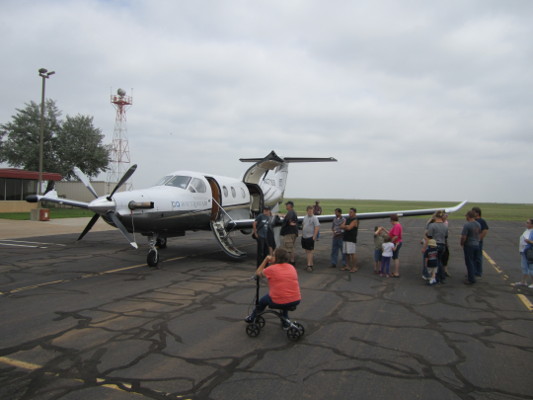
I mentioned a local airline going to Los Alamos before, but this is different. On my visit to Clovis, they showcased an air service by a company called Boutique Air, flying between Dallas and Clovis. The difference being that NM Airlines and Great Lakes are Part 121 carriers, receiving government subsidies for "Essential Air Service", while Boutique Air is a purely commercial operator. They fly a luxuriously appointed Pilatus PC-12 under an authority of Part 135, or "air taxi", which probably saves them just enought money to stay afloat. I'm sure tickets are not $45 either. It's pretty awesome that such service manages to exist in the days of late socialist America.
Posted by: Pete Zaitcev at
10:28 AM
| Comments (2)
| Add Comment
Post contains 116 words, total size 1 kb.
July 19, 2014

This VN is a little trinklet for something like 4 hours, and I only bought because there was next to nothing else to buy at Google Play. And it's not Kanon for sure. Not only story-wise, but also the port to the platform is poorly done: if the OS restarts the app, you have to continue from the last save. Fine on a laptop, not so on a tablet. Also, fonts cannot be re-sized, and there's no easy playback (or not easily found).
Art, however, is pleasing to the eye, and the protagonist is voiced, which helps to compensate for terrible fonts.
UPDATE: I should probably make a greater emphasis on the art. Typical VNs before the recent wave of anime knock-offs (such as Toradora Portable) used to sport fairly ugly art. Their CGs were done with extremely unpleasant "computer sheen" on them, too. Hime-hime Booking is different in using 100% CG, but done in a better 2010 style: it's soft and pretty. It became especially striking at desktop resolution, when I parsed my screencap stash.
Here's a fragment, cropped to its natural resolution:

Tags: anime
Posted by: Pete Zaitcev at
07:11 PM
| Comments (4)
| Add Comment
Post contains 188 words, total size 1 kb.
July 04, 2014
I bought a pound of Roshen's version of Korovka candy.

The owner of Roshen is currently the president of Ukraine and whiles his time away by giving orders for vanton bombing of population centers of Novorossia. The word of the day appears to be: Take that, Russians! Golodomor revenge with phosphorus!
Unfortunately, however, Poroshenko's candy turned out to be substandard in side-by-side testing. Not recommended.
Posted by: Pete Zaitcev at
05:37 PM
| No Comments
| Add Comment
Post contains 73 words, total size 1 kb.
June 28, 2014
Look at the picture. Notice anything interesting?
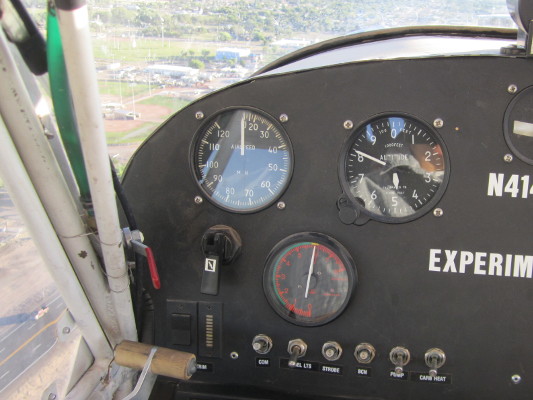
Apparently, the static port was clogged by a bug that laid eggs in it.
Since pilots are supposed to be able to fly by feel, some flight instructors use partial-panel caps to block airspeed during primary training. My primary instructor wasn't one of them, so today was my first no-instrument landing.
Another thing: I am unable to find it in the official list of Oral Examination questions on the FAA exam, but it's common to ask what happens if static port gets plugged. The real life answer is that the altimeter shows the altitude at which it was plugged, but I do not recall the official answer ever mentioning the effect on the ASI. But as we see, the airspeed is measured by the difference between pitot and static pressure, and as the static pressure gets conserved, pitot pressure drops below it as the airplane climbs. Result is the zero airspeed. It could even go negative if the instrument allowed it.
As soon as the problem manifested, I made a circuit and landed. Fortunately, the plane was built with easily removable (albeit not folding) wings, and air pressure lines had QDs in them for that purpose. So, I unlated the QDs, then blew and sucked at the lines until they cleared. Once done, I put the lines together and went on my mission.
Posted by: Pete Zaitcev at
07:39 PM
| Comments (1)
| Add Comment
Post contains 234 words, total size 1 kb.
June 20, 2014
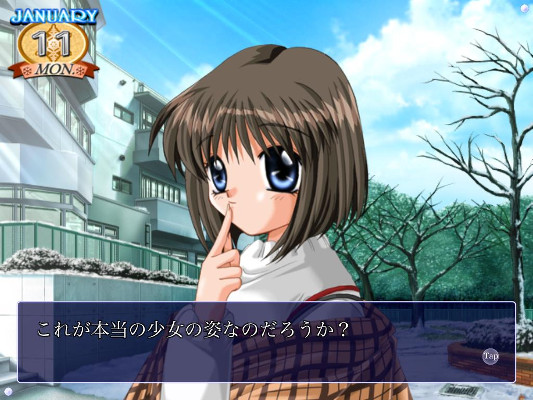
Since Kanon's value is spending the time with its characters, let's glance at what's offered. The main thing that struck me overall was how the personalities felt non-anime. Or mostly, anyway. Mai would be matching for the "dark and tall" type, and one could stretch Nayuki over a shape of "girl next door". Even those two were well developed (as we know, Lawson opened up to Mai eventually and Omo was hardcore enough for Nayuki to rage at the anime).
Yuichi's penchant for tactless jokes was so obvious that even the GameFAQs observed:
He is friendly and outgoing, and though as nice as of a person he is, he has yet to learn the sensitivity of women. He constantly teases the main cast of girls throughout the story which varies in severity depending on the girl. Despite this, he does have a soft side that likens him to an older brother as noted by Shiori Misaka.
Yeah. What's interesting, however, is how Shiori made him tone it down. Draw your own conclusions.
Shiori by herself was rather powerfuly drawn. Omo said that her defining trait was being an enigma. There's some truth to that[1], but she also emitted an intense aura of romanticism. I don't recall even seeing anything comparable in anime before. As the plot unveiled her mystery, Shiori's interplay of stoicism and weakness also came into view.
Ayu, the main heroine, develops on an ultimate idea that is familiar to anyone who's ever had an imaginary girlfriend. Still, I think the action field available to her is rather small out of necessity, since she's functionally 10 years old. She does not have a range of experiences: gastronomical ones most of all, but dealing with love too.
Makoto is handicapped by a similar problem: she does not have a full access to her own consciouseness. In practical terms, however, when she has to learn what a book or a nikuman is, it's amusing and endearing. Unfortunately, she is taken away from us too soon.
I think overall, in the game, Shiori has the deepest character and Ayu loses to her through no fault of her own. Not that it would be a productive way to look at it. Everyone offers something in this story.
[1] At some point, Yuichi observes after one of Shiori's remarks: "ã“ã‚ŒãŒæœ¬å½“ã®å§¿ãªã®ã ã‚ã†ã‹ï¼Ÿ" or, approximately, "Is this her true shape?"
Posted by: Pete Zaitcev at
08:03 PM
| No Comments
| Add Comment
Post contains 395 words, total size 3 kb.
37 queries taking 0.0669 seconds, 109 records returned.
Powered by Minx 1.1.6c-pink.




